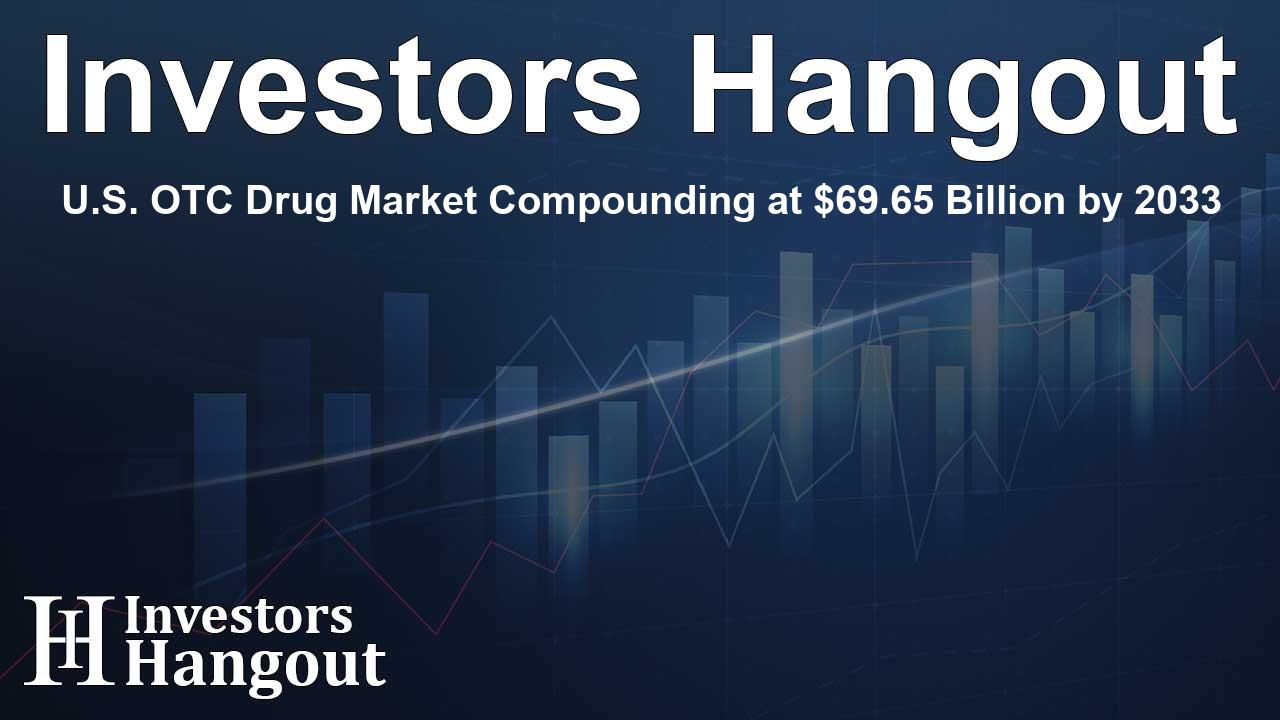U.S. OTC Drug Market Compounding at $69.65 Billion by 2033

Understanding the Growth of Over-the-Counter (OTC) Drugs
The Over-the-Counter (OTC) drug market in the U.S. is witnessing an impressive trajectory, aiming for a valuation of approximately $69.65 billion by 2033. This rise signifies a compound annual growth rate (CAGR) of 5.8% during the forecast period. The demand for OTC products underlines their essential role in America’s healthcare landscape, allowing for quick access to remedies and alleviating pressure on healthcare resources.
The Accessibility and Convenience of OTC Medications
OTC medications are a cornerstone of consumer healthcare, providing over 260 million Americans with reliable health solutions. These products are available through an extensive network comprising more than 750,000 various retail outlets, including approximately 54,000 pharmacies. The vast reach emphasizes how indispensable OTC medications are for everyday health management.
The Volume of OTC Sales
In 2023, the total sales volume for OTC products soared to about 5.67 billion units. This substantial figure reflects the persistent demand among consumers for efficient health management solutions. Notably, the frequency with which Americans purchase these medications highlights their preference for swift and uncomplicated remedies. On average, individuals buy OTC products roughly 26 times a year, significantly surpassing the frequency of doctor visits.
Key Drivers and Trends in the OTC Market
The growth of the OTC drug market is bolstered by several factors. Expanding retail networks enhance distribution efficiency, while prescription-to-OTC switches empower consumers with more options. Furthermore, robust consumer confidence in these products is critical, as it encourages ongoing use and loyalty. Not only do OTC medications cater to immediate health concerns, but their availability promotes self-care and wellness among users.
Popular OTC Product Categories
In assessing the landscape of OTC products, key categories demonstrate pronounced consumer interest. For instance, pain relievers and cold remedies top the list, showcasing the demand for symptomatic relief. In 2022, revenue from upper respiratory solutions reached $11,416 million, marking it as the highest-grossing category. Following closely are oral analgesics and personal care products, indicating that both health and hygiene are top priorities for consumers.
The Future of OTC Regulations and Innovations
Regulation is crucial in shaping the OTC drug market, as it ensures consumer safety while fostering innovation. The Food and Drug Administration (FDA) actively governs over 100,000 OTC products, enforcing standards that protect public health. Notably, regulations regarding serious adverse event reporting reflect the FDA's commitment to product safety.
Innovative Pathways in OTC Products
Innovation thrives through Rx-to-OTC switches. Over the past two decades, 45 prescription medications have gained OTC status, expanding treatment options for consumers. Such transitions not only enhance patient autonomy but also signify a shift in how individuals approach self-care. Anticipating continued growth, we can expect more medications to transition, enriching the market with novel solutions.
Consumer Behavior in OTC Medication Usage
Analyzing consumer behavior reveals significant insights into demographic trends and purchasing habits. The increased use of OTC products among younger consumers raises concerns regarding misuse. Concurrently, older adults, who might be at higher risk for adverse reactions, require clear and accessible information. These dynamics underscore the necessity for tailored educational initiatives to foster safe consumption habits.
Demographic Insights on OTC Product Consumption
Demographically, research indicates differing consumption trends based on gender and age, showing that women tend to use OTC products more frequently than men. Additionally, proper labeling practices are essential, as a significant percentage of OTC labels lack adequate information regarding potential adverse effects. This gap emphasizes the need for regulatory action to improve standardized guidelines.
Looking Ahead: Strategic Directions in the OTC Market
As digital transformations redefine accessibility, the OTC market continues to adapt to changing consumer preferences. Sales through online platforms have seen remarkable growth, indicating that convenience is a significant driver in purchasing decisions. Regulatory frameworks, such as the CARES Act, further enhance transparency, ensuring that manufacturers adhere to stringent standards in product categorization and reporting.
The Path Forward for OTC Medications
Looking ahead, the OTC market is poised for continuous evolution. Strategic initiatives focusing on consumer education, clear labeling, and improved access to products are vital for long-term success. With a robust framework supporting innovative solutions, the OTC sector can effectively meet the growing healthcare demands of consumers across the United States.
Frequently Asked Questions
What is the projected value of the U.S. OTC drug market by 2033?
The U.S. OTC drug market is projected to reach a value of approximately $69.65 billion by 2033.
What are some key drivers of growth in the OTC market?
Key drivers include expanding retail networks, Rx-to-OTC switches, and steady consumer trust in medication availability.
What categories of OTC products are most popular?
Popular categories include pain relievers, cold remedies, and personal care items, reflecting common health concerns and hygiene needs.
How does regulation impact the OTC drug market?
Regulation ensures consumer safety, while promoting innovation through strict FDA oversight of OTC products.
What trends are shaping the future of OTC medications?
Emerging trends include increased e-commerce adoption and tailored marketing strategies focusing on consumer self-care.
About The Author
Contact Dylan Bailey privately here. Or send an email with ATTN: Dylan Bailey as the subject to contact@investorshangout.com.
About Investors Hangout
Investors Hangout is a leading online stock forum for financial discussion and learning, offering a wide range of free tools and resources. It draws in traders of all levels, who exchange market knowledge, investigate trading tactics, and keep an eye on industry developments in real time. Featuring financial articles, stock message boards, quotes, charts, company profiles, and live news updates. Through cooperative learning and a wealth of informational resources, it helps users from novices creating their first portfolios to experts honing their techniques. Join Investors Hangout today: https://investorshangout.com/
The content of this article is based on factual, publicly available information and does not represent legal, financial, or investment advice. Investors Hangout does not offer financial advice, and the author is not a licensed financial advisor. Consult a qualified advisor before making any financial or investment decisions based on this article. This article should not be considered advice to purchase, sell, or hold any securities or other investments. If any of the material provided here is inaccurate, please contact us for corrections.
